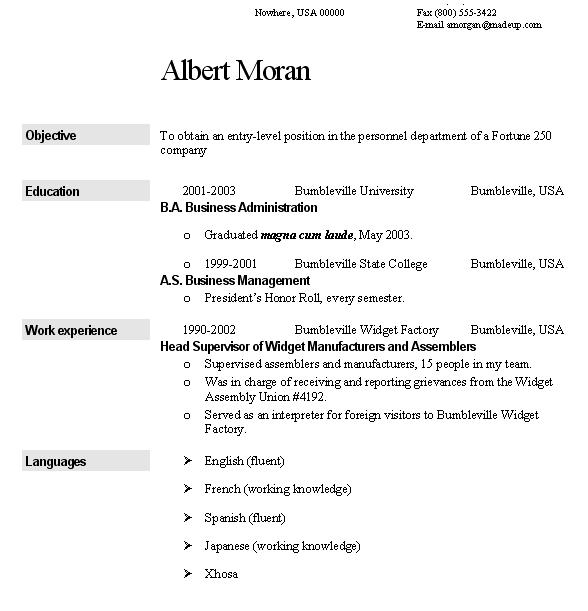|
|
Template:Wiktionary Template:Wiktionarypar
A résumé (in North American English; also sometimes spelled resumé or resume) or curriculum vitae (in Commonwealth English; sometimes abbreviated to CV) is a document containing a summary or listing of relevant job experience and education, usually for the purpose of securing a new job. Often the résumé is the first item a potential employer encounters regarding the job seeker, and therefore a large amount of importance is often ascribed to it.
| Contents |
Different forms
In American English usage, a CV will include a comprehensive listing of professional history including every term of employment, academic credential, publication, contribution or significant achievement. In certain professions, it may even include samples of the person's work and may run to many pages. In contrast, a résumé is a summary typically limited to one or two pages highlighting only those experiences and credentials which the author considers most relevant to the desired position. CVs are the preferred recruiting tool for academic and medical professions while résumés are generally preferred for business employment.
In British English, CV is the standard term for what is called a résumé in American English.
In most contexts, a résumé is short (usually one or two pages), and therefore contains only experience directly relevant to a particular position. Many résumés use precise keywords that the potential new employers are looking for, are self-aggrandizing, and contain many action words. Résumés are rarely more than two pages, as potential employers will typically not give that much time to read for each applicant.
An exception is an artist's résumé, which may run longer as it will contain a list of solo and group exhibitions (and will typically exclude any non-art-related employment) which may be more or less extensive.
Like résumés, CVs are subject to recruiting fads. For example,
- In German-speaking countries a picture is a mandatory adjunct to the CV.
- Except for the theatrical professions, a picture is strongly discouraged in U.S. CVs.
- For academic CVs in the United States, the oldest entries are generally listed first.
- For non-academic employment in the U.S., the newest entries generally come first.
- The use of an "objective statement" at the top of the document (such as "Looking for an entry-level position in xxx") was strongly encouraged in the U.S. during the mid-1990s but fell out of favor by the late-1990s.
- Listing of computer skills (such as proficiency with word processing software) was a strong differentiator during the 1980s but was considered passé for most professional positions by the 1990s.
- In most circumstances, a chronological order is considered the norm but at certain times in certain professions the preferred order was "functional" - experiences clustered to illustrate a particular skill or competency. This format may also be used by students who have not built a strong career but wish to emphasize the skill acquired through education and internship.
Example
Etymology
The word résumé is directly from French and means "summary" (but the French never use it with the same meaning as Americans and Canadians; they say CV). Curriculum Vitae is Latin for "course of life". The plural is curricula vitae, not curricula vitarum. The latter would be the genitive of content. The Latin plural would have been the former, being the genitive of possession: to an ancient Roman, "curricula vitarum" would suggest that each document described more than one life. What most people would want from a plural of CV is something meaning "a number of courses, each describing a single life"; this is curricula vitae.
External links
- ResumeWiki (http://www.resumewiki.com) - An open-content wiki devoted to résumés and other job-seeking tasks
- http://www.cvtips.com/CV_example.html
- http://www.killerres.com
- http://www.dice.com
- http://careerbuilder.com
- EServer TC Library: Résumés (http://tc.eserver.org/dir/Resumes)
- http://www.zillionresumes.com/
- Teen Resume Tips and Help For Teen Jobs (http://www.teenjobsection.com/5resumesteps)
- http://www.findaresume.com/
- http://open-site.org/Business/Employment/
- http://www.ego4u.com/en/cram-up/writing/curriculum-vitae
- http://jobsearchtech.about.com/od/resumes/l/blt_resumes.htmda:Curriculum vitæ
de:Lebenslauf fr:Curriculum vitæ nl:Curriculum vitae no:Curriculum vitae ru:Резюме sv:Curriculum vitae sr:Биографија

